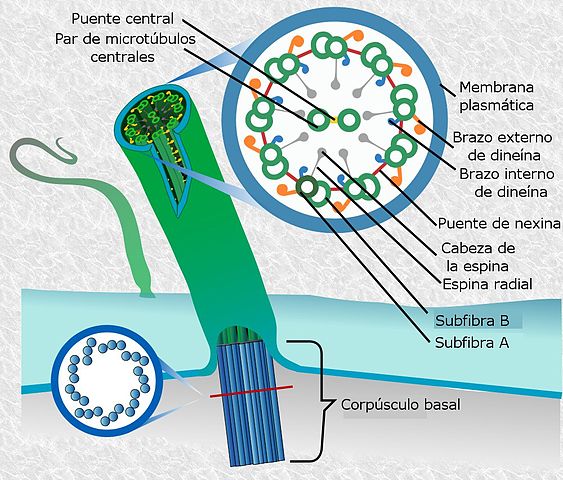Cilia and flagella
The undulipodia (cilia and flagella) are mobile extensions of the plasma membrane of certain cells, consisting of microtubules.
The flagella have the function of allowing the movement of the cell, and the cilia, creating turbulence near the cell to bring food closer together.
- The cilia are short and very numerous, covering the cell surface. Its movement is coordinated from back to front.
- The flagella are long and few, generally only 1 or 2. Their movement is wave-like.
Although prokaryotic cells can possess flagella, their structure is totally different.
Structure and composition of cilia and flagella
Cilia and flagella are made up of:
- The stem or axoneme. Surrounded by the plasma membrane and has inside:
- Two central microtubules surrounded by a thin nexin sheath .
- 9 pairs (doublets) of peripheral microtubules surrounding the central pair. In each pair, it is distinguished:
- Microtubule A: complete, with 13 protofilaments. From this microtubule, two arms of the protein dynein emerge towards the microtubule B of the neighboring pair.
- Microtubule B: with 10 protofilaments, it shares 3 with A.
This arrangement is called 9 + 2. The microtubule pairs are linked by nexin. Other nexin fibers link each A microtubule to the central sheath.
- Transition zone. It is the area where the change occurs between the structure (9 + 2) of the stem or axoneme with the structure (9 + 0) of the basal body or centriole. The two central microtubules disappear, and the peripheral doublets become triplets.
- The basal corpuscle is a cylinder located at the base of the cilium or flagellum, below the plasma membrane. It has the same structure as the centrioles (9 + 0), since it lacks the central microtubule pair, and has 9 peripheral microtubule triplets.
- Ciliary roots (not always present). They are microfilaments that emerge from the lower end of the basal corpuscle, with a contractile function, which coordinates the movement of the cilia.
